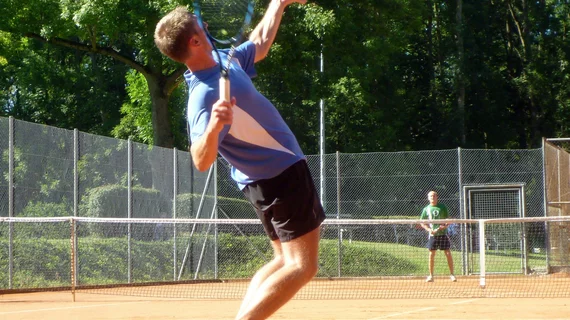Social forms of exercise tied to greatest gains in life expectancy
It’s no secret that staying physically active can add years to your life. But not all fitness activities provide equal benefit—a new study out of Denmark suggests tennis and other sports with a social element are associated with the greatest improvements in life expectancy.
Researchers followed 8,577 people from the Copenhagen City Heart Study for up to 25 years, linking their participation in various leisure-time activities against a national death registry to see if and when they passed away.
Unsurprisingly, all activities conferred a longevity advantage when compared to sedentary behavior. But tennis (9.7 years), badminton (6.2 years) and soccer (4.7 years) were associated with the greatest life expectancy gains among the eight activities studied, even after adjusting for multiple variables including age, income and education.
Lead author Peter Schnohr, MD, DMSc, and colleagues pointed out each of those sports requires at least one teammate or opponent, making social interaction a crucial element. Potentially solitary activities such as cycling, swimming and jogging were associated with life expectancy gains between three and four years. Health-club exercises encompassing weight training, treadmill and stationary bike workouts added only 1.5 years to lifespans versus being sedentary.
“Sports such as badminton and doubles tennis do not typically require strenuous exertion, but do entail a great deal of social interaction,” Schnohr and coauthors wrote in Mayo Clinic Proceedings. “Regular participation in highly interactive sports provides not only exercise but also a social support group that plays together. Belonging to a group that meets regularly promotes a sense of support, trust, and commonality, which has been shown to contribute to a sense of well-being and improved long-term health.”
Some of the findings suggest the duration of activities wasn’t particularly important; the gym-goers spent more time doing those exercises than the other groups but had the smallest improvement in life expectancy.
Other than the social element of soccer and the racket sports, the researchers suggested other characteristics may contribute to the observed boost in longevity.
“The sports that were linked to the best life expectancy gains typically require interval bursts of exercise using large muscle groups and full body movements, whereas the sports typically performed in a continuous manner showed less impressive life expectancy gains,” they noted. “This is supported by intervention studies for augmenting (cardiorespiratory fitness), in which activities such as soccer showed better improvements than did a regimen of continuous running.”
Even though the researchers attempted to adjust for socioeconomic factors, they acknowledged it is impossible to establish causality based on the observational nature of the study. Still, they believe the social aspect of sports might be important to overall health and deserves further investigation.
That means participating in team sports—or at least finding a partner to jog or bike with—could be the best way to exercise, study coauthor James O’Keefe, MD, told The New York Times.
“Raising your heart rate is important,” he said. “But it looks like connecting with other people is, too.”

